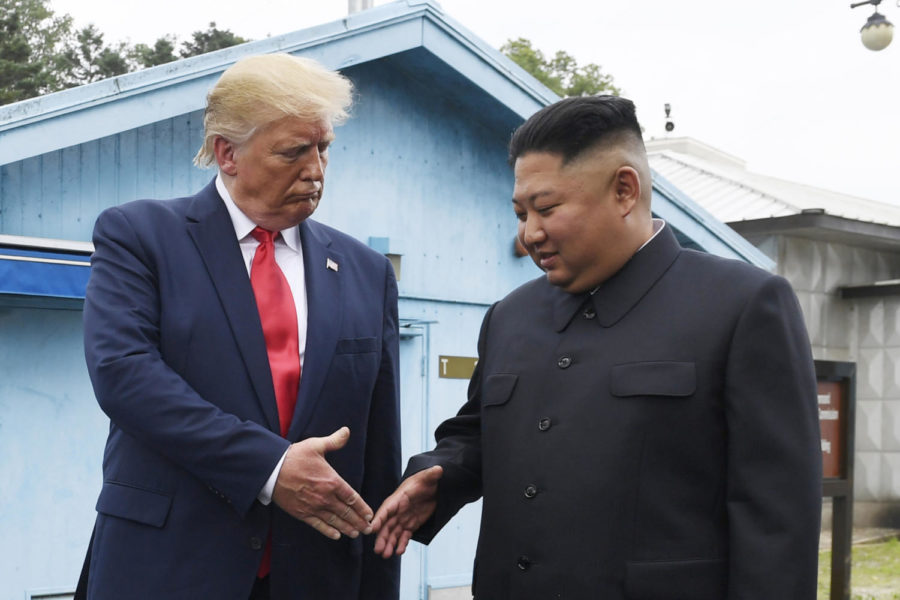An overview of the Trump presidency: Year Three 2019
FILE – In this June 30, 2019, file photo, North Korean leader Kim Jong Un, right, and U.S. President Donald Trump prepare to shake hands at the border village of Panmunjom in the Demilitarized Zone, South Korea. North Korea said it’s running out of patience with the United States over what it described as hostile policies and unilateral disarmament demands. It’s warning that a close personal relationship between their leaders alone wouldn’t be enough to prevent nuclear diplomacy from derailing. (AP Photo/Susan Walsh, File)
The year of 2019 was one of the most eventful years of the Trump administration. A major government shutdown, Robert Mueller’s investigation, and impeachment were all things that Trump had to face in his third year in office.
Following the 2018 elections, all elected congressional representatives were sworn into office on Jan. 3. Democrats took control of the House of Representatives, no longer ruled by the Republican Party. The Senate, however, would stay in power to the Republican Party.
Nancy Pelosi would also be re-elected as the Speaker of the House for a second term. This ensured that the government would be divided again.
President Trump could not get the funding for his Mexico-United States border wall through Congress and instead considered proclaiming illegal immigration at the border a national emergency. This would bypass Congress and ensure that, if not a border wall, some kind of strengthening of the border would occur.
Trump would follow up his meetings with North Korean Dictator Kim Jong-un when he and Secretary of State Mike Pompeo met with North Korean representative Kim Yong-chol. They discussed denuclearization to prepare for a future meeting between President Trump and Kim Jong-un.
On Jan. 21, the Supreme Court ruled that the Trump administration could limit the military service of transgender members, with all five conservative judges ruling in favor of Trump.
Jan. 25 would go down in history as the end of the longest government shutdown, lasting up to 35 days. The shutdown started on Dec. 28, 2018 because of a dispute between Trump and Congress about the Mexico-United States border wall. After 35 days of the government shutdown, the government reopened on Jan. 25.
On Feb. 1, Trump announced he would pull the United States out of the Intermediate-Range Nuclear Forces Treaty, claiming that Russia had openly violated the agreement. The INF treaty limited the production of short range and intermediate range missiles and missile launchers that could be used for nuclear purposes. Trump’s claims that Russia had violated the treaty came from the Russian 9M279 missile. This missile flew over the treaty limits, clearly violating the treaty and causing Trump and the rest of NATO to react.
Trump would make a move to get his Mexico-United States border wall constructed when he declared a national emergency along the southern border on Feb. 15. The declaration allowed funds to be sent to help the construction of a physical barrier along the border.
Another monumental event happened when President Trump and North Korean Leader Kim Jong-un met at a summit in the Metropole Hotel in Hanoi, Vietnam, on Feb. 27. Despite the talks ending early with no agreement being met, it was still a tremendous success for both the United States and North Korea. It helped alleviate remaining tensions between the United States and its allies and North Korea.
On March 22, Robert Mueller concluded his investigation to determine if any Russian collusion had happened in the 2016 election. It was finalized and submitted to Attorney General William Barr.
On March 24, the findings of the Mueller investigation were presented to Congress, revealing that there was no collusion between Donald Trump and Russia during the 2016 Presidential Election.
Trump threatened to close the Mexico-United States border on April 4 if Mexico did not halt the flow of illegal drugs over the border.
On May 10, Trump announced he would raise trade tariffs on China by $200 billion, raising it by 5% to a 30% tax rate. China responded by placing nearly $75 billion in tariffs on American-made imports.
On June 22, President Trump announced that he delayed the U.S. Immigration and Customs Enforcement (ICE) raids by two weeks, hoping Congress would use the time to achieve a solution to the southern border problem.
On June 30, President Trump made history when he stepped over the Korean Demilitarized Zone into North Korea. President Trump became the first United States president to step into North Korea. North Korean Leader Kim Jong-un also stepped into South Korean territory. President Trump and Kim Jong-un spent nearly an hour talking together inside of the Inter-Korean Freedom House along the Korean Border.
On Aug. 3, a shooting in a WalMart in El Paso, Texas. occurred, leaving 23 people dead and 23 injured. That same night, President Trump called the shooting an “act of cowardice.”
The next day, on Aug. 4, another shooting occurred in Dayton County, Ohio, leaving 9 dead and 23 injured. President Trump, in an address to the people, labeled both of the shootings as “barbaric slaughters” and a “crime against humanity.”
On Aug. 13, Trump announced that his administration would limit the number of green cards that would be handed out for legal immigrants.
Greenland got some consideration from Trump on Aug. 16, when he revealed his idea to purchase the island from the Danish government. The U.S. has occupied the country since World War II, and it has the potential to be used for American military facilities in the Arctic Circle. Both the Danish and Greenlandic governments declined the request to sell their territory.
On Aug. 30, President Trump tweeted an image of a failed Iranian missile launch. The USA-224 reconnaissance satellite had taken the pictures in impressively high resolution.
On Oct. 3, President Trump requested that Ukranian President Volodymyr Zelensky investigate Vice-President Biden and his family for corruption in business dealings.
On Oct. 2, President Trump announced he would pull American special forces from northeastern Syria. Withdrawing U.S. forces would allow Turkey to invade Syria and destabilize the region. Kurdish fighters would end up fighting ISIS, the Syrian government, and now the Turkish army. To make the situation even worse, ISIS prisoners that were held by Kurdish forces in north-eastern Syria were being released as Turish forces approached.
President Trump made moves to make a ceasefire in the Middle East between Turkey and Kurdish forces when he revealed new sanctions against Turkey on Oct 23. He also announced that the United States will have no more involvement in Syria, saying that he will “let someone else fight over this long bloodstained sand.”
On Dec. 5, Nancy Pelosi announced that the House of Representatives would proceed with articles of impeachment against President Trump for obstruction of Congress and abuse of power. This stemmed from a phone call President Trump made with the Ukranian President, asking him to dig up information against political rival Joe Biden.
On Dec. 18, the House of Representatives voted to Impeach Trump in a vote of 230-197 for abuse of power and 229-198 for obstruction of Congress.







